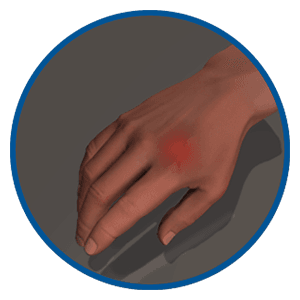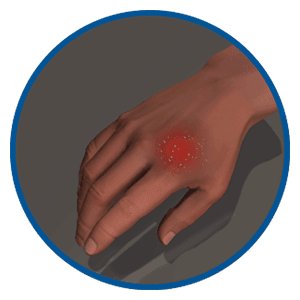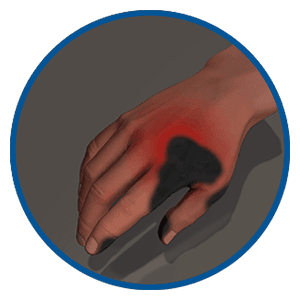Progress
Online First Aid | Burn Injuries
Treatment for Burns
Burn Classification
Burns are classified as 1st Degree (superficial), 2nd Degree (partial thickness), or 3rd Degree (full thickness) depending on the depth of the injury. The Total Body Surface Area can be quickly calculated using the "Rule of 9's".
1st Degree Burn
Epidermis
- ● The skin will appear red without any blisters
- ● The area will be painful and tender
2nd Degree Burn
Epidermis, Dermis
- ● The skin will appear red or white with blisters
- ● The area will be severely painful
3rd Degree Burn
Epidermis, Dermis, Subcutaneous Fat, Muscles
- ● The skin will appear leathery and dark brown to black
- ● The inner area will not be painful, but the outer edges will be



Burns can be left by heat, chemicals, or electricity. Heat burns are caused by contact with hot surfaces, hot liquids, steam, or fire. When treating a burn, the only thing you should put on it is cold water and a clean dressing. Ice can actually damage the burned area and make things worse.
When treating a small burn:
- ● Make sure the scene is safe
- ● Get the first aid kit
- ● Put on PPE
- ● Cool the burn area with cold water for at least 10 minutes
- ● Make sure the water isn’t ice cold
- ● If there is no cold water, use a cold (but not freezing) compress
- ● Run cold water on the burn until it no longer hurts
- ● Cover the burn with a dry, clean nonstick dressing
When treating a large burn
- ● Make sure the scene is safe
- ● Call 9-1-1 if there is a fire, if the burn is very large, or if you don’t know what to do
- ● If the person or their clothing is on fire, put the fire out. Have them Stop, Drop, and Roll. Then cover them with a wet blanket
- ● Remove the wet blanket once the fire goes out
- ● Remove clothing and jewelry that isn’t stuck to their skin
- ● Cool the burn area with cold water for at least 10 minutes
- ● Cover the burns with dry, nonstick, clean dressings
- ● Cover the person in a dry blanket
- ● Check to see if they have any signs of shock
- ● If they have a large burn, they should be seen by a healthcare provider as soon as possible to determine if any further treatment is necessary
Class: Adult/Pediatric First-Aid
Instructor: Mike Figuero
Publish Date: 2022-04-02
Last Updated: 2022-07-18
Instructor: Mike Figuero
Publish Date: 2022-04-02
Last Updated: 2022-07-18